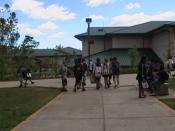The school to work program is a course that allows students to make a connection between school and the outside world. At Roosevelt High, in Portland, Oregon, the drop out rate was thirteen percent and students went directly from High School to low-paying dead end jobs because they didn't see a reason to stay in school. This program will offer students understanding of a particular occupation while being able to watch experienced workers on the job. Harriet Webster explains that existing school to work program "...includes 6 career pathways: natural resources, manufacturing and engineering, human services, health occupations, business and management, and arts and communications."
Our school and students can benefit from this program because it enables students to gain experience and a glimpse of how the real world works. It also allows them to use their academic skills in the outside world. Statistics from existing programs like Vital Link show that students that are part of this program take harder courses, perform better on state-mandated tests, do better in school, and get higher paying jobs that those who aren't part of the program.
The community and industries would also benefit from this program because more jobs are being given to people and industries would have better, more experienced workers. This program allows society to develop further by building the type of workforce useful in the future years. Businesses need employees who understand the basics of reading, writing and math and this program would allow students to apply these basics to their job. This program would involve many companies and businesses and strengthen the connections between school and work.
This program should begin to take place in middle school because it is shown that most students start to lose interest in school and drop out around middle school. They start making choices that will affect them for the rest of their lives and begin going out to earn money on their own. In this program, students are put on a job for a few hours and return to school where teachers reinforce what students have done on the job. Teachers must also encourage students to apply the academic skills learned in school to their job.
Industries must also cooperate and participate by training students and giving the schools feedback on the students' performance. Employers participating in this program should offer one of the following five activities: job shadowing, internships, mentoring, cooperative education or registered apprenticeships. Each activity is a different level for students from middle school to high school. According to the National Employer Survey, most participating employers offer job shadowing, which allows a student to follow an employee for one day or more and learn about the occupation, or mentoring, where an employee is assigned to guide a student and serve as a connection with the school on behalf of the student and the firm.
The school to work program has worked plenty for many schools all over and connects us with the outside world. Many students tend to drop out because they didn't see a reason to stay in school. This program gives students a reason to finish school and allows them to both experience working as a particular occupation and still earn the credit they need to graduate.


